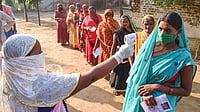As the intensity of the air pollution increases in the national capital, Delhiites are yet again back to breathing in the notorious PM 2.5— a lung cancer-causing pollutant. Delhi’s air quality index (AQI) is in a severe category and the concentration of PM 2.5 is spiking to emergency levels.
In Delhi PM 2.5 is nearly 100 times the safe limit set by World Health Organisation and long-term exposure to it can cause severe respiratory ailments, or even lead to fatal lung cancer.
The curbs and precautionary measures imposed in Delhi-NCR to tackle the pollution levels were lifted just two days ago as the quality of air showed a gradual improvement. However, since that air pollution in Delhi is expected to go worse in the coming days, the precautionary curbs are back in place.
According to some reports, 30,000 Delhites die because of air pollution every year. However, some health experts say that it is a low estimate because it does not for effects as varied as higher rates of lung cancer, diabetes, premature births, and, according to recent research, even autism.
Why is Delhi’s air often bad?
Delhi’s vulnerability to bad air pollution stems from several reasons, and one of them is its mundane geographical placement. The flat plain where Delhi sits is circumscribed by the mighty Himalayas a chain of mountains and hills that blocks the movement of air.
Smog is lifted to higher altitudes throughout the summer by an updraft brought on by the severe heat, where it is generally dispersed by monsoon winds off the Indian Ocean. However, in the winter, morning mist traps the particles at ground level. Even if there isn't often a breeze, the lid effect is nevertheless caused by colder air flowing off the mountains. As gradually as the smoke and dust build up, they immediately suspend and remain hanging in the air.
One of the factors contributing to poor air quality is motor vehicle emissions especially the emissions that come from lakhs of poorly tuned vehicles running on low-grade fuel. Besides, there are hundreds of other reasons including the emissions from the coal-fired power plants, crematoria, fire-cleared rice paddies, factories, and furnaces burning cheap pet coke and furnace oil, et al. Not to forget the spate of illicit industrial activities in the city.
How Delhites can keep themselves safe?
According to National Disaster Management Authority (NDMA), several measures can help denizens navigate through the bad air. It is better to avoid going out or indulging in outdoor activities during the early morning and evening hours. So staying indoors as much as one can, helps. But, if it is bright and sunny, one can go out.
Smoking, especially when one is living in polluted air, increases the risk of developing respiratory ailments, and hence quitting cigarettes will make one’s days way better.
One needs to detoxify the body by keeping oneself hydrated so that the adequate amount of water in the body helps in flushing the toxins out.
Doing Cardio or other strenuous exercises in the parks is a big no.
Eating fresh fruits, proteins, nuts, and foods rich in omega fatty acids will help as they are anti-inflammatory in nature, rich in antioxidants, and as well as help in boosting one's immunity.
Plants are the panacea, indoors. To keep the environment clean and a little fresher indoors, amass some air-purifying plants such as aloe vera and English ivy.
According to several media reports, the Centre's air quality panel, CAQM, said that the air quality, already in dark red zones in several parts of Delhi-NCR and that it is likely to worsen further over the next few days.
Reportedly, the panel has now asked the industries to switch to cleaner fuels and banned use of coal in the region and this directive has been welcomed by the activists and experts.


























